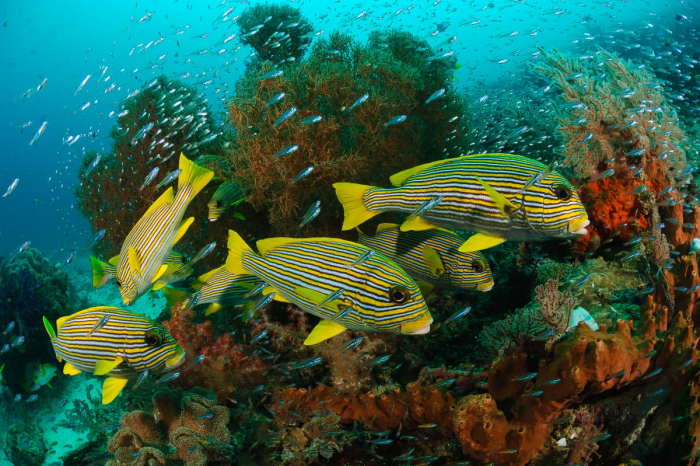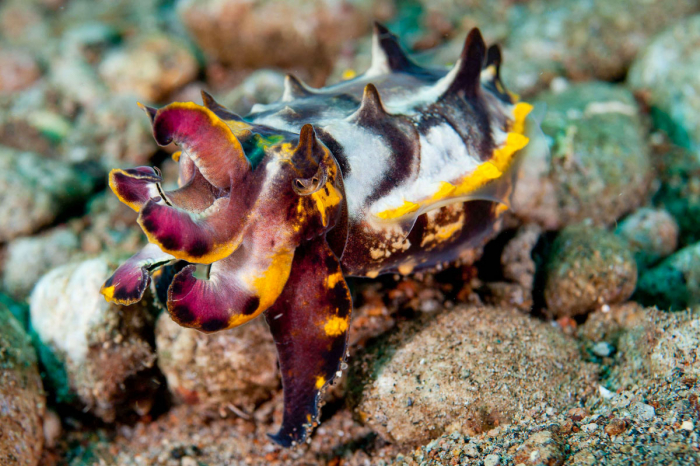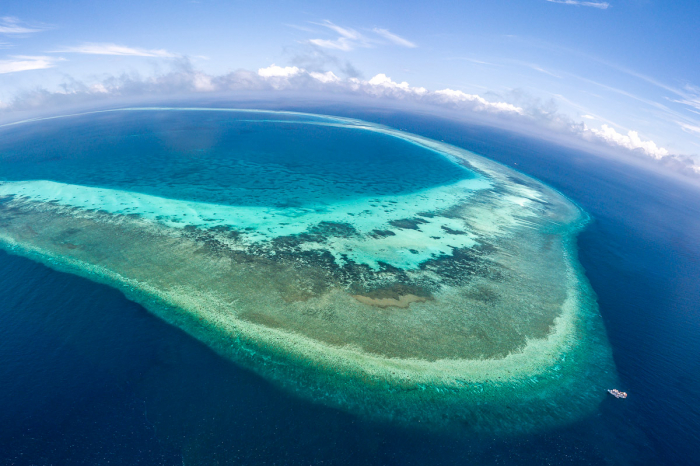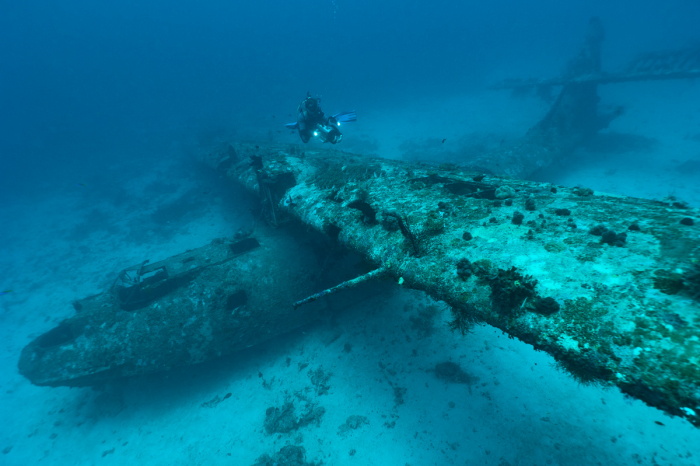Occupying a central location at the global epicentre of marine biodiversity, the island nations of Indonesia and the Philippines are among the world’s most exciting dive destinations. Throughout their sprawling archipelagos, these two dive meccas offer almost every tropical underwater experience you could possibly imagine. But which, if either, really is the best? That’s for you to decide, as we pit these two legendary dive destinations against one another once and for all.
Read on as we compare reefs and wrecks, muck and exploratory diving in a bid to uncover Southeast Asia’s best dive destination.
Unbeatable marine biodiversity
Lying at an intersection between the Indian and Pacific oceans, the Coral Triangle is the planet’s undisputed epicentre of marine biodiversity. And, with the Philippines and Indonesia making up two thirds of this roughly drawn triangle, it comes as no surprise that the diving in these two countries is both bountiful and varied.
Indonesia

Home to a whopping 18% of the world’s coral reefs, Indonesia is often regarded as the holy grail of marine biodiversity, with around 600 species of coral and over 3,000 species of fish. In fact, Raja Ampat’s Cape Kri dive site, located in the Dampier Strait, once delivered a record-breaking 374 fish species on a single dive!
Indonesia also has a reputation as a ‘species factory’, with Raja Ampat, Cenderawasih Bay, and Triton Bay of the Bird’s Head Seascape boasting particularly high levels of endemism. These remote regions seem to collect a variety of larvae swept from elsewhere on powerful oceanic currents, providing an isolated oasis within which to evolve. One particular highlight is the epaulette shark, which uses its pectoral fins like feet as it ‘walks’ across the reef - and, if necessary, sometimes even land!
Philippines
In contrast, the Philippines is home to only 9% of the world’s reefs - around half that of Indonesia - but the country itself is also substantially smaller, meaning the reef density remains more or less the same. The diversity of species within these two countries is also on a par, with the Philippines home to more than 500 species of coral and around 3,000 fish species.
Despite Indonesia’s reputation for varied and endemic marine life, the Philippines is sometimes referred to by scientists as “the centre of the centre” of marine biodiversity and is often thought to boast a higher concentration of species per unit of area than anywhere else on earth. Within the archipelago, a narrow stretch of water between Luzon and Mindoro, known as the Verde Island Passage, is believed to be the most productive ecosystem of them all. Like its Indonesian counterparts, this region is supplied with nutrients and larvae as strong currents and tidal flows sweep back and forth, creating fertile pockets of life along the way.
Macro life among the muck
Interestingly, the biodiversity in the Coral Triangle extends beyond the colourful reefs, with silty and seemingly barren dive sites often offering an even broader spectrum of life. Here, among the cracks and crevices, divers can discover an incredible array of miniature critters, each a little stranger than the last. Scouring the rubble and volcanic mud for these diverse creatures is often known as muck diving - for obvious reasons - but the phrase macro diving is also common due to the camera equipment and style used by underwater photographers to document these subjects.
Indonesia
Indonesia’s Lembeh Strait has long reigned as the world’s top muck diving destination, and for good reason. The breadth of weird and wonderful life here is so immense that we will probably never know its true extent, but a quick list of the most iconic species is enough to get any macro-maniac’s heart racing. Divers here have the chance to encounter mimic, wonderpus and blue-ringed octopuses, as well as flamboyant cuttlefish, Ambon scorpionfish, pygmy seahorses, and around eight different species of frogfish - and that’s barely scratching the surface! Of course, Lembeh is understandably popular, and has become far more accessible as a result, with relatively straight-forward travel infrastructure and a wide choice of dive resorts.
While Lembeh is somewhat of a mecca for muck diving enthusiasts, Indonesia is home to plenty of other great macro opportunities, from the Riau Archipelago to Raja Ampat. Even the popular tourist hotspot of Bali delivers some remarkably reliable critter encounters. In recent years, Alor has begun to rival Lembeh as the nation’s critter capital, offering many of the same bucket-list creatures - including plenty of Rhinopias - but with far fewer crowds. Likewise, the island of Ambon in the northern Banda Sea has quickly risen up the ranks for dedicated underwater photographers. Despite being dense with litter and rubble, Ambon’s large bay is home to an impressive diversity of macro, including the extraordinary psychedelic frogfish which can be found nowhere else in the world.
Philippines

Just a few hours south of Manila, Anilao was the birthplace of scuba diving in the Philippines. Now, more than 50 years later, this iconic destination still draws divers from all over the world who come to enjoy its calm conditions and world-class macro diving. Located in the Verde Island Passage, Anilao’s dive sites are packed with almost every critter and juvenile reef fish imaginable, from ghost pipefish and seahorses to bobbit worms and boxer crabs. Anilao is often referred to as the nudibranch capital of the world, boasting hundreds of species of these spectacular sea slugs - enough to keep avid enthusiasts occupied for an entire trip.
Further south in the Visayas, spread along several kilometres of coastline either side of Dauin near Dumaguete, lie around a dozen dive sites that can easily hold their own alongside Indonesia’s world-renowned macro hotspots. Home to plenty of the must-see animals - from pygmy seahorses to mandarinfish, and more - these dive sites are well worth exploring at any time of year. But, amongst those in the know, Dauin is held in particularly high regard due to its seasonal influxes of certain species. In April, frogfish can be found littering the dive sites here, while October and November see cephalopods of all shapes and sizes descend on this destination to dazzle divers with an array of cryptic and colourful behaviours.
Frontier diving thrills
Both Indonesia and the Philippines have long been at the forefront of the dive industry’s exploration. As once isolated destinations become more and more accessible, pioneering operators and intrepid individuals push ever further into these vast archipelagos’ most distant regions in search of the next big adventure. And, with more than 25,000 islands between them, you can rest assured that there’s plenty of dive sites yet to be fully explored.
Indonesia
Indonesia has long been at the forefront of the dive industry’s exploration. Once isolated destinations including Komodo and West Papua are now surprisingly accessible, with more hidden areas including Halmahera and East Sumbawa now enticing the most intrepid explorers.
Stretching for 1,000-kilometres from east to west, the vast Banda Sea is, without a doubt, home to many of Indonesia’s last remaining dive frontiers. Due to the sheer number and remarkable isolation of the various dive destinations here, this region is explored almost exclusively by liveaboard, with some trips spending up to two weeks on the water. Even so, you’ll likely still leave wishing for an extra day or two.
The Banda Sea is known to deliver reliable sightings of schooling hammerheads, as well as chance encounters with almost anything else you can imagine, while the far-flung Forgotten Islands offer some of the planet’s most astonishing and unique underwater experiences. A favourite for many visitors to the region is diving beneath the aptly-named Gunung Api, or Fire Mountain, surrounded by hundreds of venomous sea snakes.
Philippines

Not to be outdone, the Philippines features its own huge expanse of open water waiting to be explored. Stretching almost 800-kilometres from north to south, the Sulu Sea is a worthy contender for the title of Southeast Asia’s wildest dive frontier. But, unlike the Banda Sea, the scuba diving here is not scattered far and wide but is more or less consigned to a single marine protected area known as Tubbataha. Comprising two atolls and a lone reef in the middle of the Sulu Sea, Tubbataha is awash with coral-covered vertical reefs plunging into the darkness of the deep open ocean. As you’d expect, these walls are a beacon for big and powerful marine life, including 11 types of shark and more than a dozen dolphin and whale species.
World War Wrecks
Sought after for their natural resources, strategic positions and shelter, the many islands that make up these two nations have been fought over in the past. Some of the most recent conflicts, particularly WWII, have left behind a selection of sensational shipwrecks for divers to explore. These sunken structures open up a rare window to the past and now exist as stunning artificial reefs that showcase the region’s kaleidoscopic coral species.
Indonesia

There are few keen divers throughout the world who haven’t heard of Indonesia’s iconic Liberty Wreck. After serving in both World Wars, this 125-metre ship now lies just a few metres off Bali’s northeast coast at Tulamben and is easily accessible from the shore. With depths ranging from three to 28-metres, and a vast open structure full of swim-throughs, this impressive vessel will entertain any level of diver, from absolute beginners to advanced wreck enthusiasts.
There are many more top-quality wreck dives scattered throughout Indonesia, with a particularly interesting concentration found around the entrance to West Papua’s enormous Cenderawasih Bay. Japanese and American forces fought for control of several strategic positions in the region, leaving behind interesting wrecks in the aftermath. Off the southeast coast of Biak, divers can find a PBY Catalina amphibious bomber plane lying upright on a carpet of white sand. A little further west, near the mainland town of Manokwari, lies a 120-metre freighter with two large blast holes, known as the Shinwa Maru, as well as the Cross Wreck and several others. A P-38 Lightning aircraft can also be found near Pulau Rouw.
Philippines
At the northeastern tip of Palawan, Coron is the undisputed wreck diving capital of the Philippines. The rugged islands are home to a series of sheltered bays where an entire fleet of WWII wrecks lie, inviting exploration. In fact, no less than ten WWII wrecks can be easily dived here, as well as one or two others. Irako Maru is a large Japanese refrigeration ship measuring 146-metres in length and is one of the best wreck dives in the country. Visibility is usually good, allowing divers to get a feel for this vessel’s size, and a deep penetration route provides extra interest for advanced underwater explorers.
If you thought the Irako Maru was big, wait until you get a glimpse of the Okikawa Maru! Sat in shallow waters, this Japanese tanker measures an impressive 168-metres long and is densely carpeted in coral. Skilled wreck divers can enter this vessel through the propeller shaft and travel all the way to the engine room. Both the 140-metre Kogyo Maru and the 152-metre Kyokuzan Maru also make for interesting dives, featuring cargo holds full of cars, trucks, and even a bulldozer.
Ready to book your dive trip to Indonesia or the Philippines?
Speak to the ZuBlu travel team today





